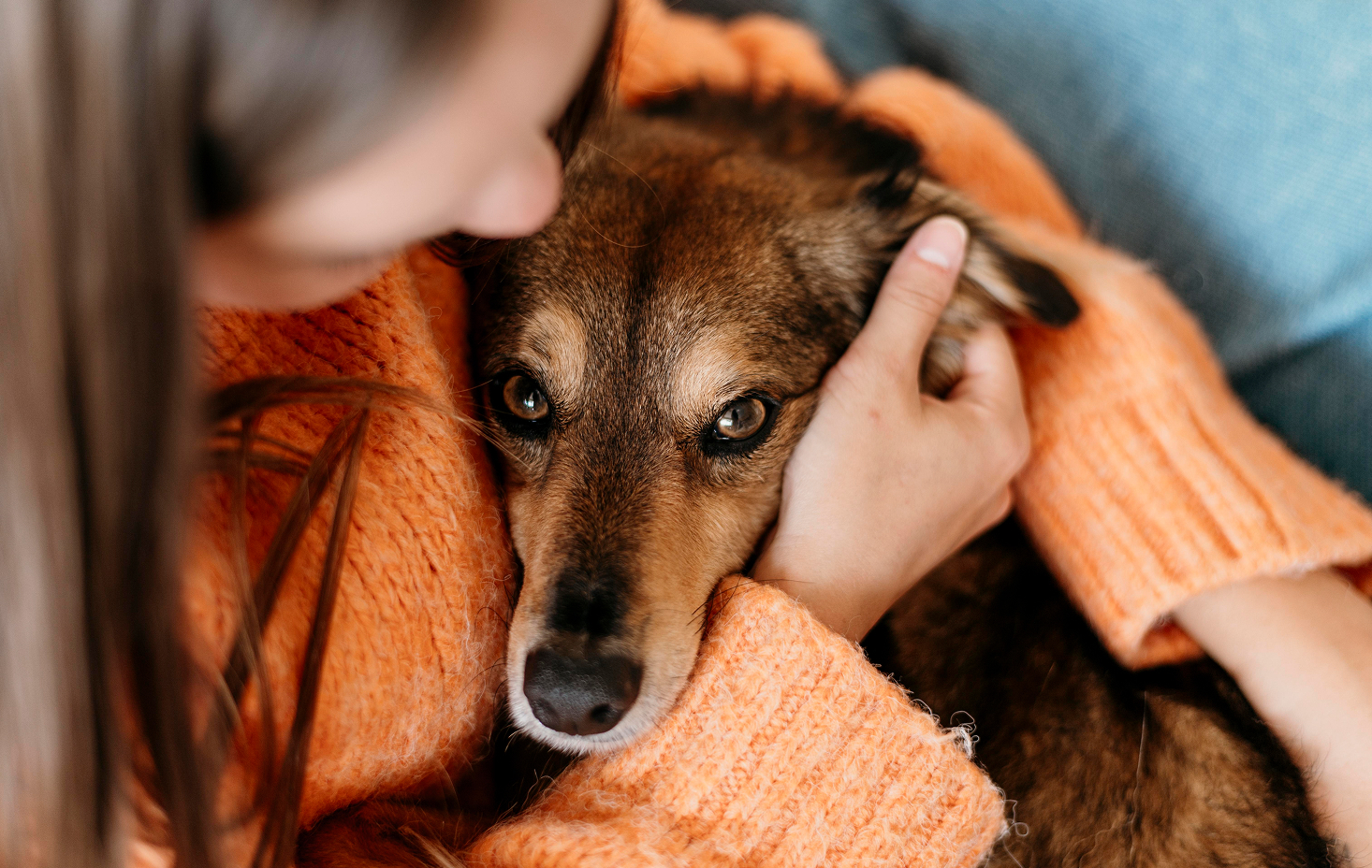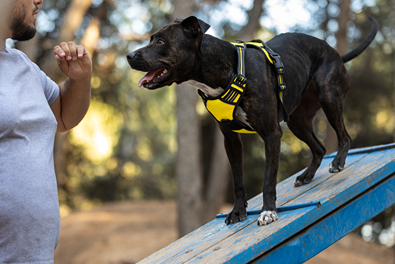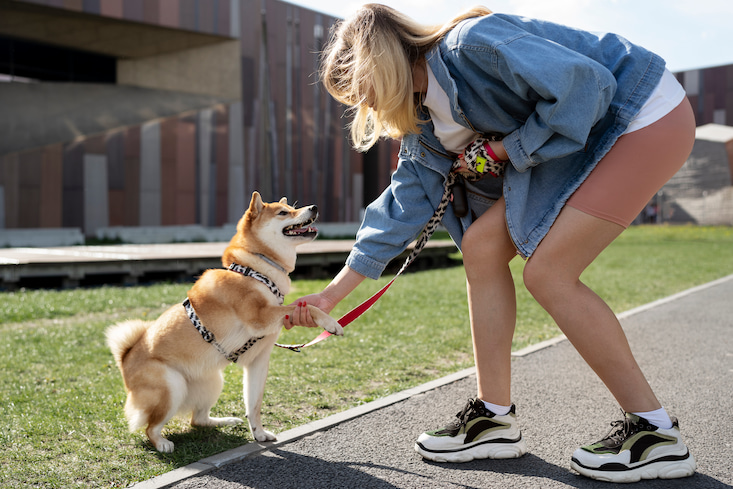Behavior modification training is a critical approach for addressing deep-rooted behavioral issues in dogs. Behavior modification is different from basic obedience training.
Behavior modification changes how a dog perceives and reacts to certain situations. This approach leads to lasting changes in behavior.
If your dog is aggressive, anxious when left alone, overly reactive, or barks too much, a behavior plan can help. A structured plan can address these issues effectively. This guide will give a detailed look at behavior modification techniques. The explanation will cover when you need them and how to use them effectively.
What is Behavior Modification Training?
Behavior modification training is a special type of dog training. It aims to change unwanted behaviors by focusing on their causes. It is not just about teaching basic commands but about modifying a dog’s emotional response to particular triggers. This approach requires a detailed understanding of different behavior modification techniques, including desensitization, counter-conditioning, positive reinforcement, and sometimes negative reinforcement.
Behavior modification aims to fix behavior problems that affect the lives of both the dog and the owner. The goal is to change how the dog sees the situation that causes the unwanted behavior. This will help the dog respond in healthier and more balanced ways.
Behavior modification is different from simple obedience training. While obedience training teaches specific commands, behavior modification changes deep-rooted behavior patterns.
Behavioral Issues Addressed by Behavior Modification
Behavior modification can effectively manage and resolve a variety of problematic behaviors, including:
- Aggressive Behaviors: This includes being aggressive toward other dogs, people, or objects.
- Resource Guarding: Dogs that protect their food, toys, or spaces may act aggressively if someone gets too close.
- Separation Anxiety: Dogs with separation anxiety may show stress.
- Reactivity: This behavior can involve overreacting to certain things like other dogs, people, or loud noises.
- Compulsive Actions: Repetitive behaviors such as tail-chasing, spinning, licking, or chewing can indicate underlying anxiety or stress.
- Fear-Based Behaviors: Dogs can show extreme nervousness, avoidance, or aggression in certain situations.
To learn more about how behavior modification helps with different issues, check out our dog training programs. We customize our methods based on each dog’s unique needs.
Techniques Used in Behavior Modification
Trainers employ several key techniques in behavior modification to help reshape a dog’s reaction to certain triggers. Each technique focuses on the dog’s emotional response. You can use them together based on the dog’s needs and the specific problem.
Desensitization
Desensitization involves exposing the dog to a trigger at a minimal intensity, gradually increasing the intensity over time. Trainers commonly use this technique for dogs with phobias, fears, or aggressive behaviors triggered by specific situations.
- Practical Application: If a dog is scared of cars, start by sitting with the dog far away from a parked car. You can slowly move closer over several sessions. Begin by starting the car’s engine while keeping it stationary. Gradually progress to having the car move at a slow pace as the dog becomes more comfortable. This slow and steady approach helps the dog become accustomed to the situation without experiencing overwhelming fear.
- Tip: Always keep the dog below its fear threshold during desensitization. If the dog becomes too anxious or reacts negatively, you may be moving too fast.
Counter-Conditioning
Counter-conditioning works by pairing a negative stimulus with something positive. The aim is to change the dog’s emotional response to a trigger from negative to positive.
If your dog is scared of fireworks, you can help by playing the sound quietly and giving treats at the same time. This can gradually change how your dog reacts.
- If your dog is aggressive toward strangers, start by having the stranger stay far away. Give your dog treats when it stays calm. Slowly bring the stranger closer, rewarding calm behavior each time.
- Important Note: Reward your dog immediately when the trigger appears to reinforce the desired response.
Positive Reinforcement
Positive reinforcement rewards desired behaviors to increase the likelihood of repeating those behaviors. This method can help train your dog to stay calm.
- Common Rewards: You should give the reward right after the desired behavior. This helps strengthen the link between the behavior and the good result.
- Consistency Matters: It’s important for everyone who interacts with the dog to use the same commands and rewards. This helps avoid confusion.
Negative Reinforcement
Negative reinforcement means taking away something unpleasant when the dog does the right thing. For example, if you release leash pressure when the dog stops pulling, it helps teach the dog to walk calmly.
- Use with Caution: Use negative reinforcement carefully, and it’s best to have a professional’s help.
By combining these methods, dog trainers can effectively address various behavioral issues. Visit our dog obedience training page.
Further reading about positive vs negative reinforment training methods
When Does a Dog Need Behavior Modification?
Understanding when to seek behavior modification for your dog can help prevent problematic behaviors from becoming entrenched. Spotting the signs that your dog needs special training helps owners take the right steps to address the issues.
Recognizing Signs that Require Intervention
The following behaviors may indicate that your dog needs behavior modification training:
- Severe Aggression: Biting, growling, or snapping at other dogs, people, or certain situations.
- Excessive Barking: Continuous barking at people, other animals, or objects, often without an apparent reason.
- Extreme Fearfulness: Cowering, trembling, or trying to escape when faced with certain triggers.
- Compulsive Actions: Repeating the same action, such as licking, chasing their tail, or spinning over and over again.
- Separation Anxiety: Displaying signs of distress, such as barking, chewing furniture, or eliminating indoors when left alone.
Start behavior modification training as soon as you see any of these signs.
How Behavior Modification Differs from Obedience Training
Behavior modification training goes beyond obedience training by addressing the root causes of problematic behaviors. Obedience training teaches dogs to follow commands.
Behavior modification aims to change how dogs react to triggers and situations. For example, teaching a dog to sit when asked is obedience training. Helping a dog overcome fear of loud noises is behavior modification.
The Role of a Professional Trainer in Behavior Modification
Some dog owners can handle mild behavior problems by themselves. However, it is best to work with a professional dog trainer or behaviorist for more serious issues.
Why Working with a Professional is Important
A professional trainer or behaviorist has the skills and experience to:
- Identify Underlying Causes: They can spot subtle signs in the dog’s body language that indicate stress, anxiety, or aggression.
- Tailor Training Plans: Experts create personalized behavior plans for dogs. They consider each dog’s history, breed, and unique behavior.
- Stay Safe: If you encounter aggression or strong fear, it’s crucial to have a trainer. The trainer should understand safe behavior modification techniques. This helps prevent injury to the dog or others.
How Professionals Develop Behavior Modification Plans
A typical behavior modification plan may involve the following steps:
- Behavioral Assessment: Observing the dog in different situations to identify triggers and behavior patterns.
- Setting Goals: Determining what behavior changes are necessary, such as reducing aggression or anxiety.
- Developing a Plan: Creating a structured training plan using a combination of techniques like desensitization, counter-conditioning, and positive reinforcement.
- Monitoring Progress: Regularly assessing the dog’s progress and adjusting the training plan as needed.
At Toko Dogs, we offer training for reactive, fearful, and aggressive dogs. Our services help owners manage, reduce, and in some cases stop their dogs behavioral problems. We create structured training plans that fit each dog’s needs.
Behavior Modification Training: Step-by-Step Guide
Implementing a behavior modification plan involves several key steps, each focusing on gradually changing the dog’s behavior.
Step 1: Identifying the Problem Behavior
Clearly define the behavior you wish to change, such as resource guarding, fear of strangers, or reactivity. Document when, where, and under what circumstances the behavior occurs, as this will help you identify triggers.
Step 2: Managing the Dog’s Environment
Adjust the environment to reduce exposure to stressors or triggers while training is in progress. This can involve using crates, gates, or other barriers to manage the dog’s movement within the home.
- Tip: Provide a safe space where your dog can retreat when feeling overwhelmed, such as a quiet room or a crate.
Step 3: Gradual Exposure to Triggers
Start the desensitization process by showing the dog the trigger at a low level. Gradually increase the exposure over time.
- Monitor Stress Levels: Watch for signs of stress, such as yawning, panting, or pacing. If the dog shows signs of stress, reduce the intensity of the exposure.
Step 4: Reinforcing Desired Behavior
Immediately reward the dog for displaying calm or positive behavior in the presence of the trigger. This reinforcement helps the dog form a positive association with the previously negative stimulus.
Step 5: Long-Term Maintenance
Consistency is crucial for maintaining the results of behavior modification. Continue practicing the techniques regularly to prevent the dog from reverting to old behaviors.
Common Mistakes in Behavior Modification Training
Avoid these common pitfalls to achieve successful behavior modification outcomes:
- Progressing Too Quickly: Moving too fast through the steps can overwhelm the dog and lead to setbacks.
- Inconsistent Training: Inconsistency in applying techniques or reward systems can confuse the dog.
- Ignoring Health Issues: Some behavioral problems have medical causes. Always rule out underlying health problems with a vet before starting behavior modification.
For more practical advice, explore our dog training blog for additional tips and techniques.
Conclusion
Behavior modification training is essential for dog owners facing serious behavioral challenges. With a proper approach, a structured plan, and professional guidance, even the toughest behaviors can improve. Consistency, patience, and understanding your dog’s specific needs are crucial for lasting success. For customized behavior modification plans, contact us to see how we can assist you and your dog.
Related Articles

Fear Periods in Dogs – What Every Dog Owner Should Know
If your confident puppy suddenly became afraid of everyday objects or your senior dog unexpectedly developed new fears, you’re not alone. Fear periods in dogs are natural developmental phases that can appear at different life stages, and understanding them is crucial for every dog owner. As San Diego’s dog training experts, we know that creating […]

The Ultimate Guide to Off-Leash Dog Training
Off-leash dog training strengthens trust and improves obedience, giving dogs the freedom to explore while staying under control. This guide covers essential commands, step-by-step techniques, and common mistakes to avoid. Learn how to safely transition your dog to off-leash adventures, ensuring a fun and secure experience for both you and your furry companion.

What is Off-Leash Dog Training and Why Does it Matter?
Off-leash dog training teaches dogs to follow commands without a leash, enhancing obedience, trust, and safety. It allows dogs to explore freely while staying responsive to their owners. This training includes key commands like “come†and “stay,†helping prevent behavioral issues and ensuring control in public spaces, making outdoor adventures more enjoyable for both dog and owner.
